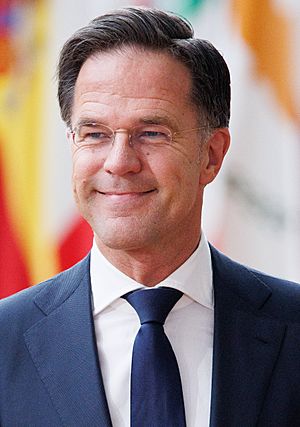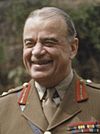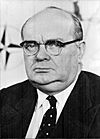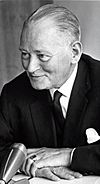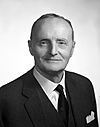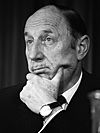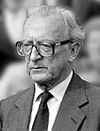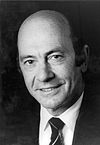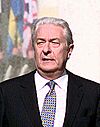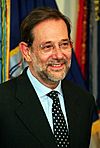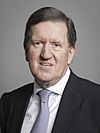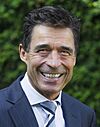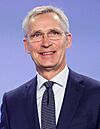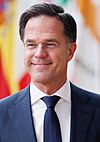Secretary General of NATO facts for kids
Quick facts for kids Secretary General of the North Atlantic Treaty Organization |
|
|---|---|

Flag of NATO
|
|

Logo of NATO
|
|
| North Atlantic Treaty Organization | |
| Abbreviation | NATO SecGen |
| Member of | North Atlantic Council |
| Seat | NATO headquarters |
| Appointer | Member states |
| Term length | Four years, renewable |
| Formation | 24 March 1952 |
| First holder | Hastings Ismay, 1st Baron Ismay |
| Deputy | Deputy Secretary General |
The Secretary General of NATO is the main leader of the North Atlantic Treaty Organization (NATO). NATO is a group of 32 countries that work together for safety and defense. The Secretary General is like a top manager and spokesperson for this important group.
This person helps coordinate how the alliance works. They lead NATO's international staff, which is like their team. They also lead most of the important meetings, like those of the North Atlantic Council. However, they do not lead the military meetings.
The Secretary General does not command soldiers. Decisions about politics, military actions, and overall plans are made by the member countries. The Secretary General works closely with other top officials, like the head of the NATO Military Committee.
The current Secretary General is Mark Rutte. He used to be the Prime Minister of the Netherlands. He started his role on October 1, 2024.
Contents
How the Role Started
NATO was formed to help countries protect each other. In 1949, the North Atlantic Treaty was signed. This treaty said that NATO members needed to create a council. This council would have representatives from each country.
At first, the North Atlantic Council met once a year. It was made up of the foreign ministers from each NATO country. But soon, they realized they needed to work together more often. So, in 1950, they decided to have "Council deputies." These deputies were based in London and worked full-time. They helped manage the organization every day.
The deputies were given the power to make decisions for the Council. Their first chairman was Charles Spofford from the United States. As NATO grew, it became more organized. In 1951, NATO was restructured to make its operations smoother. The deputies gained more power. They could represent their governments on all matters, including defense and money.
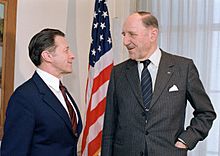
Because the organization was growing, NATO decided it needed a single senior leader. This person would manage all the civilian parts of NATO. In February 1952, the position of Secretary General was officially created. This new leader would control the civilian staff and lead the North Atlantic Council meetings.
The first person chosen for this big job was Hastings Ismay. He was a general from World War II and a British politician. He started on March 24, 1952. Ismay was chosen because of his military background and his experience as a diplomat. He had strong support from all NATO countries.
After Ismay retired in 1957, Paul-Henri Spaak became the second Secretary General. Spaak was a diplomat and former Prime Minister of Belgium. He did not have military experience. His appointment showed that NATO was also focusing on political and diplomatic issues. The Council even gave the Secretary General more power to help solve disagreements between member countries.
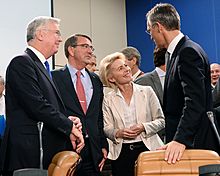
Who Has Been Secretary General?
The first Secretary General was chosen in 1952. Since then, twelve different people have held this important job. They have come from eight different countries. The Netherlands has had four Secretaries General. The United Kingdom has had three. Belgium has had two. Italy, Germany, Spain, Denmark, and Norway have each had one. Sometimes, when a Secretary General leaves, a temporary "acting" Secretary General steps in.
| No. | Portrait | Secretary General | Took office | Left office | Time in office | Previous office | Country of origin |
|---|---|---|---|---|---|---|---|
| 1 | General Hastings Ismay 1st Baron Ismay (1887–1965) |
24 March 1952 | 16 May 1957 | 5 years, 53 days | Secretary of State for Commonwealth Relations |
||
| 2 | Paul-Henri Spaak (1899–1972) |
16 May 1957 | 21 April 1961 | 3 years, 340 days | Prime Minister of Belgium | ||
| 3 | Dirk Stikker (1897–1979) |
21 April 1961 | 1 August 1964 | 3 years, 102 days | Minister of Foreign Affairs | ||
| 4 | Manlio Brosio (1897–1980) |
1 August 1964 | 1 October 1971 | 7 years, 61 days | Ambassador to the United Kingdom |
||
| 5 | Joseph Luns (1911–2002) |
1 October 1971 | 25 June 1984 | 12 years, 268 days | Minister of Foreign Affairs | ||
| 6 | Peter Carington 6th Baron Carrington (1919–2018) |
25 June 1984 | 1 July 1988 | 4 years, 6 days | Secretary of State for Foreign and Commonwealth Affairs |
||
| 7 | Manfred Wörner (1934–1994) |
1 July 1988 | 13 August 1994 † | 6 years, 43 days | Minister of Defence | ||
| – | Sergio Balanzino (1934–2018) Acting |
13 August 1994 | 17 October 1994 | 65 days | Deputy Secretary General of NATO |
||
| 8 | Willy Claes (born 1938) |
17 October 1994 | 20 October 1995 | 1 year, 3 days | Minister of Foreign Affairs | ||
| – | Sergio Balanzino (1934–2018) Acting |
20 October 1995 | 5 December 1995 | 46 days | Deputy Secretary General of NATO |
||
| 9 | Javier Solana (born 1942) |
5 December 1995 | 14 October 1999 | 3 years, 313 days | Minister of Foreign Affairs | ||
| 10 | George Robertson Baron Robertson of Port Ellen (born 1946) |
14 October 1999 | 17 December 2003 | 4 years, 64 days | Secretary of State for Defence | ||
| – | Alessandro Minuto-Rizzo (born 1940) Acting |
17 December 2003 | 1 January 2004 | 15 days | Deputy Secretary General of NATO |
||
| 11 | Jaap de Hoop Scheffer (born 1948) |
1 January 2004 | 1 August 2009 | 5 years, 212 days | Minister of Foreign Affairs | ||
| 12 | Anders Fogh Rasmussen (born 1953) |
1 August 2009 | 1 October 2014 | 5 years, 61 days | Prime Minister of Denmark | ||
| 13 | Jens Stoltenberg (born 1959) |
1 October 2014 | 1 October 2024 | 10 years, 0 days | Prime Minister of Norway | ||
| 14 | Mark Rutte (born 1967) |
1 October 2024 | Incumbent | 1 year, 98 days | Prime Minister of the Netherlands |
What the Secretary General Does
The NATO Secretary General leads several important groups within NATO. They chair the Defence Planning Committee. They also lead the Nuclear Planning Committee. These are key military organizations.
The Secretary General also leads the Euro-Atlantic Partnership Council. This group helps NATO work with other countries. They also lead the Mediterranean Cooperation Group. This group focuses on cooperation in the Mediterranean region. They are also a joint leader of the Permanent Joint Council and the NATO-Ukraine Commission.
Another main job is leading NATO's staff. The Secretary General directs the international staff. This staff includes people from all NATO member countries. They also have their own private office to help them. To assist with all these duties, the Secretary General has a deputy. This deputy is appointed by the organization. The NATO Military Command Structure consists of two strategic commands, directed by the International Military Staff:
The commands under SACEUR - Allied Joint Force Command Brunssum, Allied Joint Force Command Naples and Joint Force Command Norfolk are Operational Level Commands, while Headquarters Allied Air Command, Headquarters Allied Maritime Command and Headquarters Allied Land Command are Tactical Level Commands. SACEUR also has operational command of the Joint Support and Enabling Command.
- Liaison: Provides advice and support to the NAC
| Political strategic level: | |||||||||||||||||||
| North Atlantic Council | |||||||||||||||||||
| Secretary General of NATO Brussels, BE |
International Staff Brussels, BE |
||||||||||||||||||
| Military strategic level: | |||||||||||||||||||
 Chair of the NATO Military Committee International Military Staff
Brussels, BE |
|||||||||||||||||||
SACEUR (ACO, SHAPE) Mons, BE |
 SACT (ACT, HQ SACT) Norfolk, US |
||||||||||||||||||
| Operational level: | |||||||||||||||||||
How a Secretary General is Chosen
There is no strict rule for how the Secretary General is picked. Instead, the NATO member countries usually agree on one person. This decision often happens through informal talks between countries.
The top military leader of NATO, called the Supreme Allied Commander Europe, is usually from the United States. The Secretary General has traditionally been from a European country. However, there is nothing in NATO's rules that says a Canadian or American cannot become the Secretary General.
Deputy Secretary General
The Deputy Secretary General helps the Secretary General. This person is also very important in NATO's leadership.
| # | Name | Country | Duration |
|---|---|---|---|
| 1 | Jonkheer van Vredenburch | 1952–1956 | |
| 2 | Baron Adolph Bentinck | 1956–1958 | |
| 3 | Alberico Casardi | 1958–1962 | |
| 4 | Guido Colonna di Paliano | 1962–1964 | |
| 5 | James A. Roberts | 1964–1968 | |
| 6 | Osman Esim Olcay | 1969–1971 | |
| 7 | Paolo Pansa Cedronio | 1971–1978 | |
| 8 | Rinaldo Petrignani | 1978–1981 | |
| 9 | Eric da Rin | 1981–1985 | |
| 10 | Marcello Guidi | 1985–1989 | |
| 11 | Amedeo de Franchis | 1989–1994 | |
| 12 | Sergio Balanzino | 1994–2001 | |
| 13 | Alessandro Minuto-Rizzo | 2001–2007 | |
| 14 | Claudio Bisogniero | 2007–2012 | |
| 15 | Alexander Vershbow | 2012–2016 | |
| 16 | Rose Gottemoeller | 2016–2019 | |
| 17 | Mircea Geoană | 2019–2024 | |
| 18 | Radmila Šekerinska | 2024– |
See also
 In Spanish: Secretario general de la Organización del Tratado del Atlántico Norte para niños
In Spanish: Secretario general de la Organización del Tratado del Atlántico Norte para niños
- Supreme Allied Commander Europe
- Chairman of the NATO Military Committee


